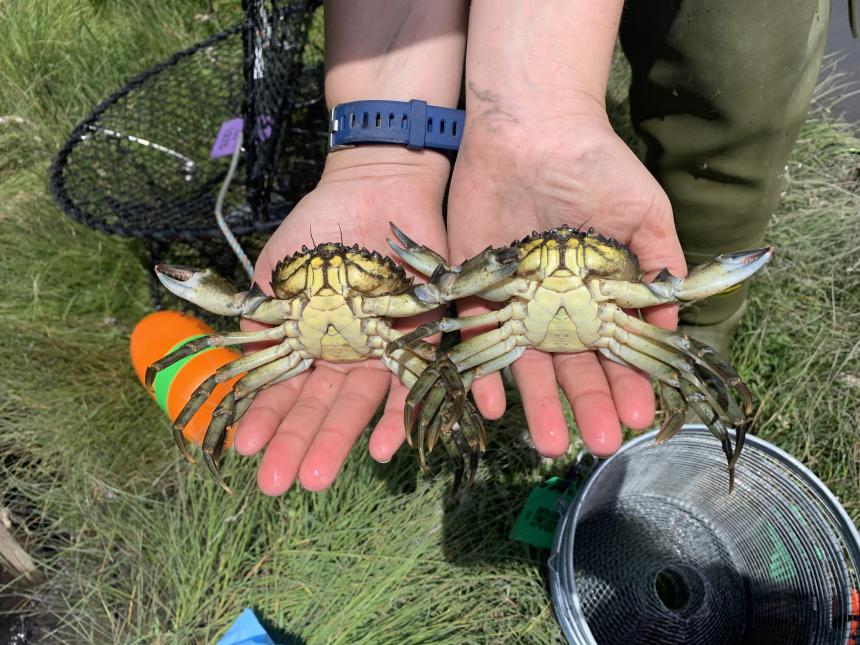If you find a suspected European green crab or its shell in Washington, take photos and report it as soon as possible using the form on the European green crab identification and reporting page. Review WDFW's crab identification guide (PDF), and take pictures to confirm identification. At this time, we are not asking the public to kill suspected green crabs. This may sound counterintuitive but is intended to protect native crabs from cases of mistaken identity. As a Prohibited species, it is illegal to possess a live European green crab in Washington.
This species webpage includes detailed management updates and resources. For information for the public on identifying and reporting European green crabs, please visit the European green crab identification and reporting page.
For updates, please click the Conservation tab below. You can also find catch updates and more information on our interactive European Green Crab Hub (wdfw.wa.gov/greencrabhub), which supports coordination of emergency measures, data collection, and science. Or sign up for our European Green Crab Management Updates email list.
An increasing threat
The European green crab (Carcinus maenas) is a globally damaging invasive species that poses a threat to native shellfish, eelgrass, and estuary habitat critical for salmon and many other species.
Potential impacts include destruction of eelgrass beds and estuarine marsh habitats, threats to the harvest of wild shellfish and the shellfish aquaculture industry, salmon and forage fish recovery, and a complex array of ecological impacts to food webs. Research is ongoing regarding potential impacts on juvenile Dungeness crab and crab fisheries.
In areas where European green crabs have been able to establish large populations for extended periods of time, they have had dramatic impacts on other species, particularly smaller shore crabs, clams, and small oysters. While green crabs cannot crack the shell of a mature oyster, they can prey upon young oysters, and will dig down six inches to find clams to eat. One green crab can consume 40 half-inch clams a day, as well as other crabs its own size. Their digging can have significant negative impacts on eelgrass, estuary and marsh habitats.
Learn more in this recorded presentation from Washington Department of Fish and Wildlife (WDFW)'s aquatic invasive species research scientist. The below Northwest Now video segment from August 2022 also covers European green crab concerns and management in Washington.
Description and Range
Physical description
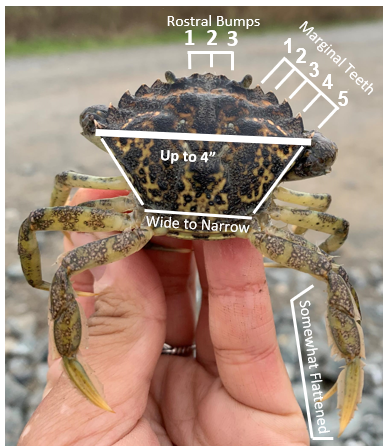
European green crabs are shore crabs and are found in shallow areas—typically less than 25 feet of water—including estuaries, mudflats, intertidal zones, and beaches. They are not likely to be caught by recreational shrimpers or crabbers operating in deeper water, but may be encountered by beachgoers, waders, clam and oyster harvesters, or those crabbing off docks or piers in shallow areas.
The most distinctive feature is not its color – which can vary from reddish to a dark mottled green – but the five spines or teeth on each side of the shell. There are three rounded lobes between the eyes; and the last pair of legs are somewhat flattened. The carapace is broader than it is long and seldom exceeds 4 inches across.
In Washington state, the European green crab is most often confused with the native hairy shore crab, helmet crab, and kelp crab.
Download WDFW's Crabs of Washington identification guide (PDF). Or download this WDFW flier with European green crab reporting information and photos of native crab species.
Geographic range
The European green crab first became established the United States in the mid 1800s, arriving by ship to the Cape Cod region. In the early 1900s they spread northwards, where they are believed to have contributed to the dramatic declines in the soft shell clam fishery as far north as Nova Scotia. In 1989, green crabs were first discovered on the West Coast in San Francisco Bay, California and made it into Oregon, Washington, and British Columbia coastal estuaries in the late 1990s helped by strong El Niño currents. They were detected in southeast Alaska in 2022.
European green crabs were discovered on the Washington coast in 1998 in Willapa Bay and Grays Harbor, and later in Makah Bay. European green crabs were first documented in the Salish Sea at Sooke Basin, British Columbia in 2012, and in the San Juan Islands in 2016.
Beginning around 2018, state and federal agencies, tribes, and partners began to detect significant increases in European green crabs—potentially linked to warmer water conditions, especially in 2021—in areas including Willapa Bay, Grays Harbor, Makah Bay, and Lummi Bay.
Current range
While infestations are present at locations along the Washington Coast as well as in Lummi Bay in Whatcom County and Sooke Basin on southern Vancouver Island in British Columbia, European green crab numbers remain low across other areas of the Strait of Juan de Fuca, San Juan Islands, and Bellingham and Padilla bays. They were first detected in Hood Canal in 2022 and near Port Gamble in 2025.
European green crabs have not been confirmed in the Salish Sea south of Hood Canal and Whidbey Island. Early detection monitoring continues across central and south Puget Sound.
Refer to this link for a larger version (PDF)of the map below showing where European green crabs were detected in Washington waters in 2024.
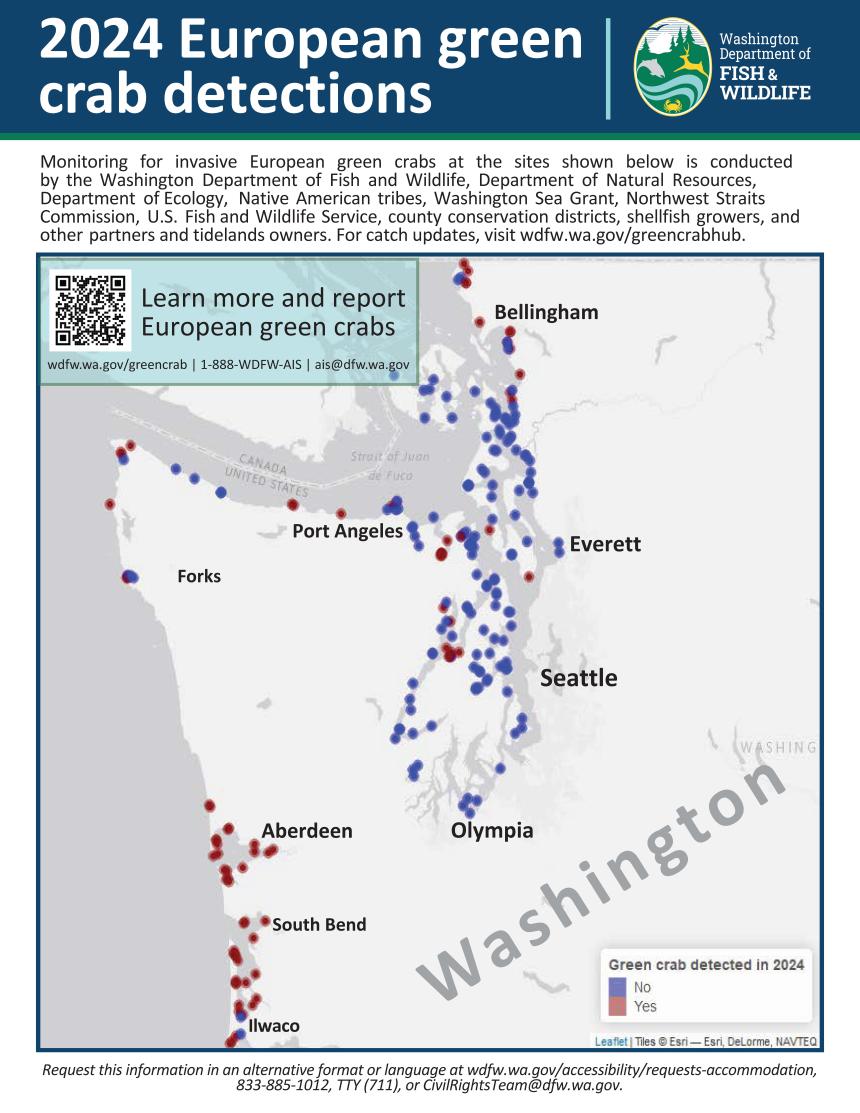
Regulations
Rules and seasons
WDFW is not asking the public to kill suspected green crabs. This is to protect native crab species, which are often misidentified, particularly helmet, kelp, and hairy shore crabs. It might be hard to let a crab go when you are concerned it could be invasive, but keep in mind WDFW will respond quickly to confirmed sightings in new areas, and the best thing you can do is to get the information to us as soon as possible.
European green crab are classified as a Prohibited Level 1 Invasive Species in Washington, meaning live crabs may not be possessed or retained, introduced on or into a water body or property, or trafficked (transported, bought or sold), without department authorization, a permit, or as otherwise provided by rule.
Under Washington state regulations, prohibited invasive species may be killed and returned to the water where they were found, or retained once dead, if the person is certain about species identification and assumes responsibility for correct identification and adherence to state rules and fishing regulations. This regulation is also included in the crab rules section of the Washington Sport Fishing Rules.
Targeting EGC with traps requires a permit from WDFW. For those who own or manage shellfish beds, beaches, or tidelands, support and permits for European green crab control may be available. Please contact ais@dfw.wa.gov.
Beachgoers, anglers, recreational crabbers, and others are asked not to tamper with European green crab traps, which are often deployed in shallow areas exposed at low tide and are typically identified with a bright orange buoy and an official green tag or permit.
WDFW, West Coast tribes, agencies, and other partners continue researching and experimenting with responsible ways to use the biomass from European green crabs that have been trapped, removed from Washington waters, and humanely killed through freezing, including for compost or fish feed.
Conservation
Management plan for European green crab
A six-year management plan for European green crab in Washington is now in place through June 2031. The plan was developed in recognition that European green crab pose a significant, long-term threat to Washington's coastal ecosystems and species, as well as the economic, cultural, recreational, and subsistence resources of tribes and coastal communities. Management of green crab along the vast coastline of Washington poses a difficult challenge requiring a long-term, collaborative approach emphasizing local management with WDFW oversight as the state lead management agency. Not only must efforts be made to detect and rapidly respond to the introduction of green crab to new locations, but continual control efforts are necessary at locations where established populations threaten priority resources.
WDFW and partners have focused much of ours efforts in the early detection of green crabs by monitoring locations that offer good habitat for the species. If the species is detected at a new location, WDFW conducts rapid response trapping and/or ongoing control trapping and other actions to reduce or eliminate those new populations, and to prevent the spread of European green crab from established locations.
WDFW European green crab updates
- June 2025 - European Green Crab Quarterly Progress Report – Spring 2025
- May 2025 - News release: Invasive European green crabs detected near Port Gamble
- May 2025 - European Green Crab Letter to Congress (PDF)
- March 2025 - European Green Crab Quarterly Progress Report – Winter 2024
- Nov. 2024 - European Green Crab Quarterly Progress Report – Fall 2024
- Sept. 2024 - European Green Crab Letter to Congress regarding federal funding (PDF)
- Sept. 2024 - European Green Crab 2025-2031 Management Plan for Washington
- Sept. 2024 - News release: Long-term management plan published for controlling invasive European green crabs
- Sept. 2024 - European Green Crab Quarterly Progress Report – Summer 2024
- Aug. 2024 - News release: European green crabs detected in Quillayute River estuary near La Push
- May 2024 - European Green Crab Quarterly Progress Report – Spring 2024
- April 2024 - European green crab federal funding requests (PDF) (two-pager)
- April 2024 - Letter to Quinault Indian Nation in response to European Green Crab State of Emergency (PDF)
- March 2024 - European Green Crab Quarterly Progress Report – Winter 2023
- Feb. 2024 - Blog post: Cases of mistaken crab identity underscore request to report and release suspected European green crabs
- Dec. 2023 - European Green Crab Public Update (PDF) (Nov/Dec)
- Dec. 2023 - European Green Crab Quarterly Progress Report - Fall 2023
- Nov. 2023 - News release: Invasive European green crab report leads to rapid response at Salt Creek Recreation Area
- Oct. 2023 - European Green Crab Public Update (PDF) (Sept/Oct)
- Sept. 2023 - European Green Crab Public Update (PDF) (July/August)
- Sept. 2023 - European Green Crab Quarterly Progress Report – Summer 2023
- June 2023 - European Green Crab Public Update (PDF) (May/June)
- June 2023 - News release: WDFW launches online hub for coordinated management of invasive European green crab
- June 2023 - European Green Crab Quarterly Progress Report – Spring 2023
- April 2023 - European Green Crab Public Update (PDF) (March/April)
- March 2023 - European Green Crab Letter to Congress (PDF)
- March 2023 - European Green Crab Letter to NOAA (PDF)
- March 2023 - European Green Crab Quarterly Progress Report – Winter 2022
- Feb. 2023 - Letter on EGC and Prohibited invasive species to shellfish shippers, dealers (PDF)
- Feb. 2023 - European Green Crab Public Update (PDF) (January/February)
- Jan. 2023 - European Green Crab FY23 Strategic Action Plan (PDF)
- Dec. 2022 - European Green Crab Public Update (PDF) (November/December)
- Dec. 29, 2022 - News release: Live European green crabs confiscated from seafood market; species remains prohibited in Washington
- Dec. 13, 2022 - European Green Crab Management Update (PDF)(one-pager)
- Dec. 2022 - European Green Crab Quarterly Progress Report – Fall 2022
- Oct. 2022 - European Green Crab Public Update (PDF)
- Sept. 2022 - European Green Crab Public Update (PDF)
- Aug. 2022 - European Green Crab Public Update (PDF)
- July 2022 - European Green Crab Public Update (PDF)
- June 26, 2022 - News release: Emergency measures deployed to control invasive European green crabs in Washington waters
- May 19, 2022 - News release: Community science volunteers discover invasive European green crab in Hood Canal
- Jan. 20, 2022 - Blog post: European green crab increase warrants emergency actions
- Jan. 19, 2022 - Governor's Emergency Proclamation 22-02 (PDF)
Please contact ais@dfw.wa.gov for earlier updates, or read on for additional information.
Emergency measures deployed to control invasive European green crabs
In 2021, WDFW, tribes, and partners identified an exponential increase of invasive European green crabs (EGC) within the Lummi Nation’s Sea Pond and outer coast areas, including Makah Bay, Grays Harbor, and Willapa Bay. This poses an imminent threat to Washington’s economic, environmental, and cultural resources. The $2.3 million appropriated by the State Legislature for EGC management in the 2021-23 biennium was not sufficient to control these exploding populations.
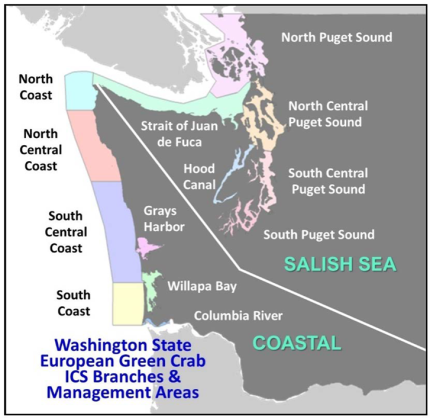
On Dec. 14, 2021, Director Susewind submitted an emergency measures request (PDF) for invasive green crab response to Governor Jay Inslee. While emergency funding was not immediately available, on Jan. 19, 2022, Gov. Inslee issued an emergency order (PDF) to address the exponential increase in the European green crab population within the Lummi Nation’s Sea Pond and outer coast areas. The proclamation directs WDFW to begin implementation of emergency measures and urges the Legislature to provide additional emergency funding as requested by the WDFW as soon as possible.
Working with the Governor’s office, the Office of Financial Management, tribes, and Washington Sea Grant, WDFW requested $8,568,00 million from the State Legislature during the 2022 supplemental session to control increasing European green crab populations; including emergency funding in the remainder of Fiscal Year 2022 and funding through Fiscal Year 2023. The Legislature fully-funded this request in the 2022 Supplemental Budget, which was signed by Gov. Inslee. This level of state funding was continued in 2023-2025.
The Washington State Emergency Management Division assigned European green crab response as a formal mission # 22-1085 on April 18, 2022. After meeting with other state and federal agencies, the Washington Department of Fish and Wildlife (WDFW) Director Kelly Susewind formally implemented an Incident Command System (ICS) on May 5, 2022. The ICS also identifies Coastal and Salish Sea management branches.
With the emergency order and funding, WDFW has been working with tribes, other state and federal agencies, as well as shellfish growers and private tidelands owners to establish a coordinated response, hire and deploy personnel, and purchase and distribute equipment to areas with known green crab infestations.
ICS objectives
- Facilitate WDFW implementing Governor’s Emergency Proclamation for statewide emergency measures with respect for tribal sovereignty and federal jurisdictions.
- Prioritize the health and safety of all participants.
- Reduce or contain EGC populations below levels that result in environmental, economic, and cultural resource harm, and prevent permanent establishment in new areas.
- Maintain collaborative and transparent emergency management.
- Progress towards post-emergency transition to long-term EGC management by local tribal co-managers and partners with WDFW oversight, utilizing the 2025-2031 Management Plan for Washington.
2023-25 Biennium Updates
WDFW’s Aquatic Invasive Species (AIS) unit anticipates deploying more than 25 staff and 1,000 traps during the field seasons, along with other equipment and resources.
In April 2023, the Washington State Legislature and governor continued the level of funding with $6,082,000 appropriated annually for green crab management in the 2023-25 Operating Budget that runs through June 2025.
For 2023-2025, WDFW is funding co-managers, tribes, and partners for continued statewide EGC management as part of the approximately $12 million dollars appropriated by the Washington State Legislature in this biennium. In total, nearly $9 million will be passed through including:
- $2.5 million for the Pacific and Grays Harbor Conservation Districts to support coastal work;
- $2.9 million to the Lummi Nation;
- $950,000 to the Makah Tribe;
- $1.34 million to Washington Sea Grant;
- $800,000 to the Washington Department of Natural Resources;
- $640,000 to the Washington Department of Ecology; and
- $200,000 to the Recreation and Conservation Office (RCO).
Shellfish Transfer Permits
Washington State prohibits the release of non-native species into Washington’s waters and the intentional import of live green crabs. To reduce risk of unintentional introductions, WDFW restricts movement of shellfish from green crab areas and requires that anyone seeking to move live shellfish into or around state waters be approved for an import or transfer permit, which may include precautionary treatment measures to further reduce risk.
Washington Sea Grant Crab Team
WDFW has teamed up with the Washington Sea Grant “Crab Team” who is leading a volunteer-based early detection and monitoring program for green crab. The Crab Team is also working to improve the understanding of native salt marsh and pocket estuary organisms and how they could be affected by green crabs.
To learn more about early detection, monitoring, and volunteer opportunities, please visit the Sea Grant’s Crab Team website.
Salish Sea Transboundary Action Plan
As the prevention of green crab infestations requires widespread help, WDFW worked with the Canadian Department of Fisheries and Oceans, the Puget Sound Partnership, and Washington Sea Grant to develop the Salish Sea Transboundary Action Plan.
For more information on European green crab management in British Columbia, see this webpage from the Invasive Species Council of B.C., or watch this new video from Coastal Restoration Society about green crabs on Vancouver Island.
National European Green Crab (EGC) Management and Control Plan
Published in June 2023, the National European Green Crab (EGC) Management and Control Plan (PDF) was developed by a multi-agency European Green Crab Working Group for implementation by the Aquatic Nuisance Species Task Force. More information is available on the U.S. Fish and Wildlife Service webpage.
The purpose of the EGC Management Plan is to guide local, state, and federal agencies, Tribal communities, and other stakeholders in detecting EGC in the earliest stages of invasion, responding rapidly to new detections to determine extent of invasion, and implementing immediate containment or eradication actions. This plan aims to serve as the baseline for the development and implementation of, as well as the integration with, regional plans such as the Salish Sea Transboundary Action Plan.
Resources
You can also find more information on our interactive European Green Crab Hub (wdfw.wa.gov/greencrabhub), which supports coordination of ongoing emergency measures, data collection, and science.
A European Green Crab Management Updates email list is also available at wdfw.wa.gov/about/lists. Or review this one-pager (PDF) directing to the below materials, graphics, talking points, and more.
Outreach and identification materials
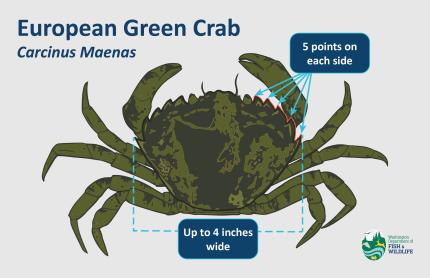
General information and educational materials:
- Crabs of Washington identification one-pager (PDF)
- Map of Washington European green crab detections in 2024 (PDF)
- Invasive European green crabs in Washington interactive StoryMap
- European green crab in Washington Plain Language Talking Points (PDF)
- Invasive European green crabs in Washington presentation (PDF)
- Map of Washington European green crab ICS Branches and Management Areas (PDF)
- Washington European green crab management definitions (PDF)
Outreach materials:
- European green crab identification and reporting sign for beaches, marinas, boat ramps, water access areas, etc.
- Español/Spanish: Señal de informe de cangrejos verdes europeos (PDF)
- European green crab identification flier (PDF)
- European green crab informational poster (PDF)
- European green crab wallet-sized ID card (PDF)
- Español/Spanish: Tarjeta de identificación de cartera de cangrejos verdes europeos (PDF)
- Tiếng Việt/Vietnamese: Thẻ căn cước ví cua xanh châu Âu (PDF)
- Invasive European green crabs rack card/brochure (PDF)
- Español/Spanish: Folleto/tarjeta publicitaria de cangrejos verdes europeos invasivos (PDF)
- Tiếng Việt'Vietnamese: Thẻ/tờ rơi về loài cua xanh châu Âu xâm lấn (PDF)
- українська/Ukrainian: Інвазивні європейські зелені краби. Картка/брошура (PDF)
- Soomaali/Somali: Kaarka rack carsaanyada cagaaran ee Yurub ee duulaanka / buug-yaraha (PDF)
- 中国人/Chinese/Mandarin: 欧洲青蟹入侵架卡/小册子 (PDF)
- ខ្មែរ/Khmer/Cantonese: ខិត្តប័ណ្ណក្តាមបៃតងអឺរ៉ុប (PDF)
If your organization is interested in acquiring printed copies of these materials, please contact ais@dfw.wa.gov.
Graphics:
- European green crab identification graphic
- European green crab coloring sheet (PDF)
- European green crab identification image with labels
- European green crab sticker
Additional resources:
- Washington Sea Grant European green crab identification guides
- Washington Sea Grant European green crab Informational Handout (PDF)
- USGS Invasive European Green Crabs: A threat to Washington's shellfish industry infographic (2022)
- European Green Crab: Alaska Invasive Species Partnership video from U.S. Fish and Wildlife Service (2024)
Presentations, videos and webinar recordings
View our European Green Crab playlist on YouTube for all recordings.
- European green crabs in Washington with Brian Turner, Ph.D. | Jan. 13, 2025 (WDFW lunchtime seminar)
- European Green Crab Public Update Webinar (hosted by Washington Invasive Species Council during Invasive Species Awareness Week) - Feb. 28, 2024
- European Green Crab Public Update Webinar (hosted by Washington Invasive Species Council during Invasive Species Awareness Week) - Feb. 21, 2023
- European Green Crab Stakeholder/Partner Meeting (Salish Sea) - Feb. 15, 2022
- European Green Crab Stakeholder/Partner Meeting (Outer Coast) - Feb. 17, 2022
Environmental education resources and curriculum
- Wild Washington lesson plan: Green Crab Alert: Invasion in Washington's Waters, 7th grade mini unit (2024)
- Wild Washington lesson plan: Aquatic Invasive Species, 6th to 8th grade (2021)
- Wild Washington webinar: Getting Crabby: Exploring Careers Working with European Green Crabs (2021)
Please see the Conservation section above or contact ais@dfw.wa.gov for additional reports and information.
